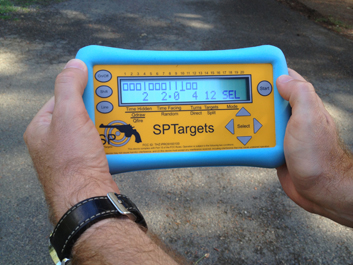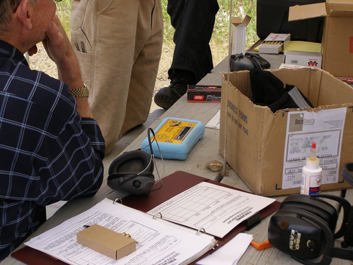SPTargets Turning Target and Running Man systems are supplied with a wireless remote Control Unit as standard equipment.
The Control Unit has the advantage of total portability, enabling the instructor to operate without the restrictions of control cables. The instructor is free to view the performance of officers under training or test from any distance and viewpoint thus improving training efficiency and range safety
The SPTargets Control Unit is a compact, power-efficient, battery-operated unit designed from the ground up for target control use. It utilizes a minimum number of control buttons positioned in a logical arrangement that simplifies both learning how to use the unit and subsequent unit operation.
Since the Control Unit is self-contained and does not require the use of a central computer, the complete control system is easier to install and operate, and less expensive to purchase and maintain, than a computer-based system. The Control Unit can be programmed to operate an indefinite number of targets as a group, and it can be custom-programmed to meet the special requirements of any training organization. As a guide, the standard control program is described below.
Standard Control Program
The following is the standard control program installed in the Control Unit:
- Time Hidden (target edge-on) options in seconds
1, 2, 3, 4, 5, 6, 7, 8, Quick-fire random time, Quick-draw random time. - Time Facing options in seconds
1.0, 1.5, 2.0, 2.5, 3, 4, 5, 6, 7, 8, 9, 10, 12, 15, 18, 20, 25, 30, 40, 50, 60, Random time. - Number of turns in sequence
1 to 16 inclusive, Direct Control (manual button operation) - Number of targets in use
The maximum number of targets available is, of course, dependent on the range, and the Control Unit is programmed accordingly. Generally the number of targets in use can be reduced if required and the targets can be further “split” into groups. For example, on a 20-target range, two sub-groups of 10 targets can be selected which provides 10 active targets and 10 inactive targets. If required, this group of 10 active targets can then be treated as two further sub-groups of 5 targets. The movements of targets in each group of 5 targets are the same.
Built-in Modes of Operation
For all of the following operations the timing, the number of turns executed, and the number of targets in use is selected on the lower line of the Control Unit display. The boldfaced three-letter headings used below are the abbreviations that appear on the Control Unit display when that mode is selected. (The expression in parentheses following the abbreviation shows how the abbreviation was derived).
- SEL. (SELect). The targets required to operate are selected on the top line of the 2-line display.
- 1RD. (1 RanDom). One target will turn to face, as chosen at random by the computer, for each turn instruction. The randomly selected targets will face the shooter for the number of turns selected in the “Turns” option.
- 2RD. (2 RanDom). Two targets will turn to face, as chosen at random by the computer, for each turn instruction. The randomly selected targets will operate for the number of turns selected in the “Turns” option.
- RIP. (RIPple). The targets will turn in a “ripple” pattern starting with target number one and continuing for the number of targets selected. As one target turns away from the shooter the next target in line turns to face him/her thus providing a basic “running man” sequence. (This sequence should not be confused with SPTargets’ dedicated Running Man target system.)
- SEQ. (SEQuence). The targets turn in sequence, the next target in the sequence turning for each press of the “Start” button. This permits “shoot-house” type operations where the t targets are positioned in a simulated building. The instructor causes each target to turn when required by simply pressing the “Start” button but he/she does not need to look at the control unit, thus enhancing safety, since the control unit controls the sequence of targets.
- WIP. (WhIP). A more complex target movement sequence designed to improve trainee reaction time.
- Other control options can be provided at user request.
Technical Specifications
Materials
- Case: ABS plastic
- Protective cover: Silicone rubber
Power Requirements
- 4 standard AA batteries
Dimensions
- Case dimensions: 7.5 x 4 x 1.25 inches
- With protective cover: Maximum 8.5 x 4.75 x 1.625 inches
Weight
- Case with cover and batteries: 24 ounces



